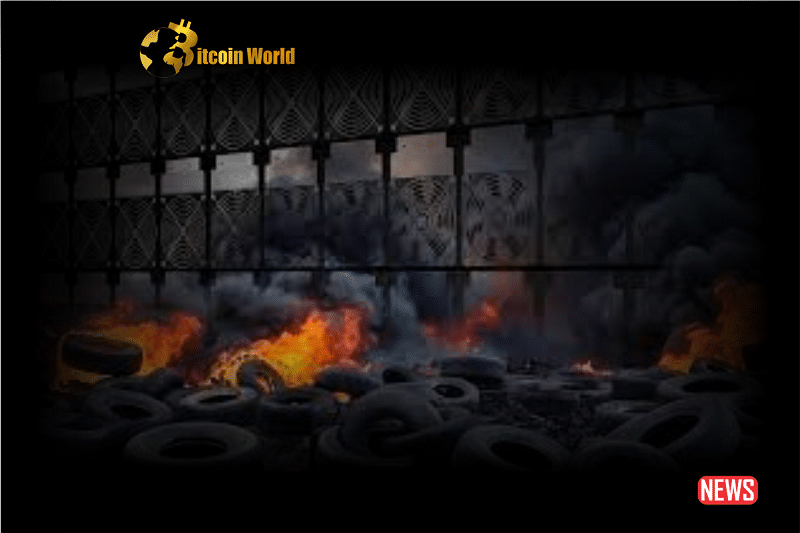The world of cryptocurrency mining is constantly evolving, with companies exploring innovative – and sometimes controversial – ways to power their energy-hungry operations. Imagine this: the digital realm of Bitcoin, fueled by… old tires? That’s precisely what Stronghold Digital Mining, a prominent player in the crypto mining space, is attempting in Pennsylvania. But this unconventional approach has ignited a firestorm of debate, pitting environmental concerns against the demands of the digital economy.
Burning Rubber for Bitcoin: What’s the Deal?
Stronghold Digital Mining has turned to tire-derived fuel (TDF) – essentially, burning shredded tires – to power its cryptocurrency mining activities. While the idea of repurposing waste might sound initially appealing, the reality is far more complex and has raised serious eyebrows. Why the controversy?
- Environmental Impact: Burning tires releases harmful pollutants into the air, water, and soil. This is a well-documented issue, raising concerns about the health and well-being of nearby communities.
- Local Opposition: Residents of Carbon County, Pennsylvania, where Stronghold operates, are understandably worried about the potential health risks and environmental degradation.
- Ethical Questions: Is burning tires, with its known environmental downsides, a justifiable way to power an activity like Bitcoin mining, which some see as having limited tangible local benefits?
The Toxic Truth About Tire-Derived Fuel
Let’s be clear: burning tires isn’t like tossing a log into a fireplace. It’s a process that releases a cocktail of harmful substances. Think about it – what happens when rubber burns? The resulting emissions can be quite nasty. Reports highlight the potential for air and water contamination, impacting local ecosystems and human health. This is a major sticking point for environmental activists and concerned citizens alike.
Stronghold’s Stance: Necessity or Justification?
Stronghold defends its approach, with spokesperson Naomi Harrington stating that tire fuel becomes necessary when coal refuse – another fuel source they utilize – lacks sufficient energy content. They’ve even secured a permit to test TDF and are seeking authorization to use a significant amount – 78,000 tons annually. But is this a pragmatic solution or a way to cut costs, as some critics suggest?
Conflicting Views: EPA vs. Local Communities
Interestingly, the US Environmental Protection Agency (EPA) has, in the past, suggested burning tires as an alternative to landfill disposal. This highlights the complex nature of waste management and energy production. However, the residents on the ground in Carbon County are far from convinced. Carol Etheride, a local resident, voiced a common sentiment of disbelief that tires would be burned to power something like Bitcoin mining, which doesn’t offer direct benefits to the community.
What Do the Experts Say?
Legal and environmental experts have weighed in, emphasizing the potential downsides. Charles McPhedran from Earthjustice considers tire combustion a “last resort” disposal method. Rob Altenburg of PennFuture suggests a more financially driven motive for Stronghold’s adoption of TDF. The core issue remains: are the potential environmental and health risks worth the energy gained for cryptocurrency mining?
Beyond Tires: Stronghold’s Energy Mix
It’s worth noting that Stronghold also utilizes coal waste to generate electricity. This, too, raises environmental questions but also presents a potential benefit. How so?
- Repurposing Waste: Stronghold extracts coal ash from dormant mines, which can pose a contamination risk. By using it, they’re potentially mitigating existing environmental hazards.
- Grid Independence: Utilizing on-site fuel sources can reduce strain on the national electricity grid.
However, the use of coal, even waste coal, is still a point of contention for environmental advocates.
The Road Ahead: Balancing Tech and Ecology
Stronghold’s venture into tire-derived fuel highlights a critical challenge: how do we balance the demands of the burgeoning cryptocurrency industry with the imperative of environmental responsibility? This situation raises several key questions:
- Are there truly sustainable energy solutions for cryptocurrency mining?
- What level of environmental impact is acceptable in the pursuit of digital currencies?
- How can communities ensure their voices are heard when new technologies and industries move in?
Conclusion: A Burning Question for the Future
Stronghold Digital Mining’s decision to utilize tire-derived fuel is more than just an operational choice; it’s a microcosm of the broader tensions between technological advancement and environmental stewardship. As the cryptocurrency landscape continues to evolve, the debate surrounding sustainable energy sources will only intensify. The situation in Pennsylvania serves as a stark reminder that innovation must be coupled with a deep consideration for its ecological consequences. The smoke from burning tires may power Bitcoin today, but the long-term environmental cost is a question that demands careful consideration and a commitment to finding truly sustainable solutions.
Disclaimer: The information provided is not trading advice, Bitcoinworld.co.in holds no liability for any investments made based on the information provided on this page. We strongly recommend independent research and/or consultation with a qualified professional before making any investment decisions.


